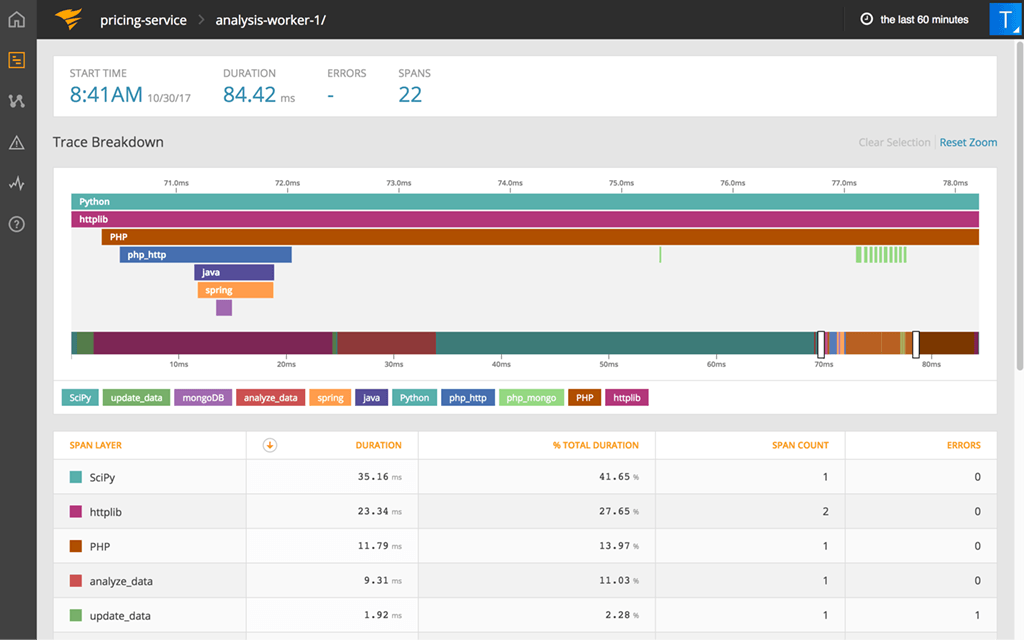Today we’re here to show you the ropes on PHP monitoring. You’ll learn how to monitor the performance of your PHP applications. But why is doing this valuable in the first place?
It used to be common for application performance to be considered a non-functional requirement. Things have changed, though. Nowadays, more and more software professionals have come to think of performance not as a nice-to-have, but as the most important must-have. Slow has become the new down, and today nobody can afford downtime.
This is true for all tech stacks. But it’s particularly important when it comes to web applications, especially customer facing applications. Since the competitor is always one click away, offering poor performing web apps is a sure way to invite your customers to become former customers. Since PHP is still one of the most popular languages for web development, it makes sense to talk about how to use APM to improve the performance of your PHP apps.
That’s exactly what we’re doing today. We’ll start with some PHP monitoring 101, doing a quick recap of how PHP apps look today. We’ll talk about some essential attributes web apps must have to remain competitive, and how APM tools can help them acquire those traits.
Then, we’ll get to the main part of this post, where we’ll offer you a step-by-step list of best practices you should put into place to start leveraging PHP monitoring in your organization.
PHP Monitoring Basics
As promised, let’s start with some fundamentals of PHP monitoring—and performance monitoring in general.

The State of PHP Applications in 2021
Before we get into the monitoring specific parts of the post, let’s take a brief diversion to talk a bit about the state of PHP today. It’s important to cover this since PHP has something of a bad reputation among some development circles. Much of this is due to problems in older versions of the language that have since been fixed.
So, what do PHP apps look like in 2021?
You might have heard PHP development is a chaotic environment with no regard for software engineering best practices. That might have been true…circa 2004.
Nowadays, PHP is a much more mature and stable language. Thanks to initiatives such as the PHP FIG (Framework Interoperability Group) and due to influences by modern frameworks such as Laravel, much of PHP development’s chaotic nature is a thing of the past.
When it comes to security, things have also improved. Several features that represented a security hazard—such as the infamous magic quotes—have been removed from the language in more recent versions. There are also built-in security facilities—like the password_hash function—that free developers from having to come up with their own security functionality.
Finally, PHP has overcome its former reputation of being “just a scripting language.” Many types of applications are now being developed with the language, from CMSs to accounting software, social networks, and even games.
The Importance of High Availability in Web Applications
Though poor performance can bring severe consequences to your application, regardless of platform or tech stack, web development is certainly the space where it creates more havoc.
Here’s a non-exhaustive list of woes poor performance can bring to your door.
- Fewer people will find your app since search mechanisms punish slow sites.
- Even if some of the users make it to your site, fewer of them will buy, since bad performance hurts conversion rates.
- Poor performance hurts the user experience in general. It’s also particularly bad when it comes to accessibility since your slow web app especially hurts those with a slower internet connection, or entry-level mobile devices.
But poor performance can cause more severe problems since it can be a symptom of yet undiagnosed defects potentially bringing your app down. And now we’ve got to what’s probably the number one trait of a successful web app—high availability.
Unlike physical, local businesses, web applications are global. Even when users in a given time zone are asleep, billions of other potential customers are awake and ready to buy whatever product or service you sell.
Not being able to leverage this world-wide audience is a huge disadvantage, and that’s why you have to do everything within your reach to keep your applications fast with as little downtime as possible.
APM Tools to the Rescue
I hope you’re convinced poor performance is a serious problem and you need to fight back. How do you do that, though?
An important step is to learn and adopt tried-and-true best practices for PHP performance. These best practices can range from code optimizations to configurations on the server and even extend into front-end territory, with tips for minifying assets and leveraging CDN’s.
However, best practices can only go so far. After all, software is exceptionally complicated, and things will go wrong. So, we need a strategy that hopes for the best but is ready for the worst. When things go wrong, we want to be notified. We need alerts. We need monitoring. That’s where APM and APM tools come in useful.
APM stands for Application Performance Monitoring. It’s the process and technique of monitoring an application, keeping track of how it behaves and performs. Using APM, you can find and fix whatever’s causing your application’s performance issues.
But the benefits of APM tools can go way beyond that. A great APM strategy can help developers diagnose and fix bugs before shipping their code to QA, lead to an overall better user experience, and help you identify potential security problems.
PHP Monitoring: How to Get There in Practice
Let’s now cover the practical steps you should take to get your PHP applications ready for monitoring.
Don’t Reinvent the Wheel
When trying to create your APM strategy, it’s important you don’t reinvent the wheel. Instead of rolling out your own monitoring solutions, leverage a tool previously built on top of years of customer feedback. Use a tool proven by established tools and platforms.
Why is this important? Easy: creating and maintaining a PHP monitoring solution isn’t your core business. Diverting development resources into creating and maintaining a APM solution from scratch would most likely be wasteful and as good a job as you will do, it doesn’t compare to a tool built based on the problems identified by thousands of IT professionals. .
The best route is for you to take advantage of mature APM solutions while your developers keep doing what they do best—deliver value to your organization.
Define Valuable Metrics and Alerts
For a valuable APM strategy, you’ll need to define a set of metrics to track when monitoring your application, PHP or otherwise.
Only picking a bunch of metrics isn’t enough, though. You need to be able to track them in real time. With an APM tool such as SolarWinds® AppOptics™ you’re able to leverage thousands of out-of-the-box and custom metrics, using its pre-populated dashboards to get updates on those metrics in real time.
But only looking at metrics isn’t enough either. It’s a passive way to monitor the state of your applications. To take your approach to the next level, you need a more actionable and active approach.
That’s where alerts come in handy. By defining alerts, you ensure the right person is notified when some of your metrics go beyond the thresholds defined by you. By using an APM tool that integrates with messaging services (such as Slack) you make the whole process easy and transparent.
Leverage a Mature APM Tool
The last and probably most important step I want to share is this: leverage an APM tool. Adopting not just any tool, but a mature, stable, tried-and-true solution will allow you to start your PHP monitoring strategy as quickly as possible.
We invite you to try AppOptics. Thanks to its PHP agent, AppOptics makes it possible for you to start monitoring your PHP applications under a few minutes.
Automate as Much as Possible
In software, everything that’s automatable should be automated. So, the second item on our list says when trying to bootstrap your APM strategy, you should automate as much as possible.
What does that mean in more practical and specific terms? It means, for instance, integrating APM into your CI/CD pipeline. If you already have automated tests and static code analysis, among other checks, adding an APM is a next logical step and with AppOptics it’s quick and painless.
By integrating APM into your automated checks, you add yet another barrier to prevent you from shipping code that doesn’t meet your standards.
PHP Monitoring: Adopt It, Minimize Bugs, and Maximize Profit
If there’s one inescapable fact the software industry has learned after roughly eight decades of existence, it’s software is incredibly complicated. No matter how great your QA strategy and testing processes are, you will ship faulty software. I guarantee you that.
Unfortunately, you’re also likely to ship slow software. Performance problems are bad for any type of application, but it’s particularly harmful for web applications. After all, when the competitor is one click away, you can’t afford to give your users a poor UX.
In today’s post, we’ve offered a series of steps/best practices you can take to bootstrap your APM strategy with PHP. By following those steps and leveraging a mature APM solution such as AppOptics, you ensure you can start your monitoring journey with the least amount of friction, and then you can start reaping the benefits as soon as possible.
This post was written by Carlos Schults. Carlos is a .NET software developer with experience in both desktop and web development, and he’s now trying his hand at mobile. He has a passion for writing clean and concise code, and he’s interested in practices that help you improve app health, such as code review, automated testing, and continuous build.














